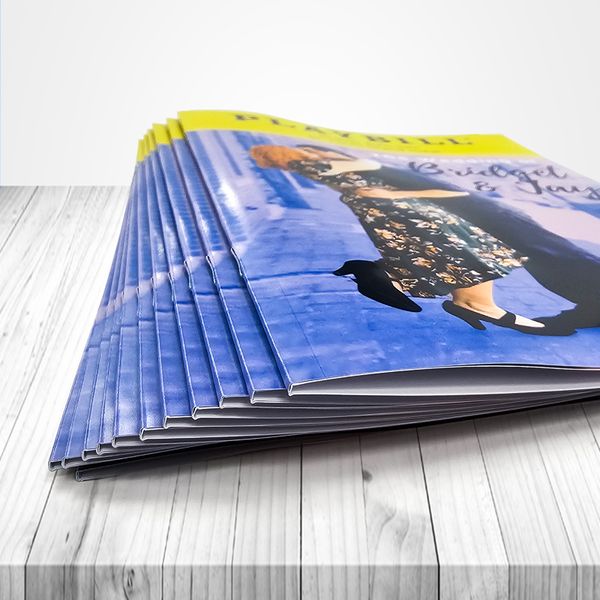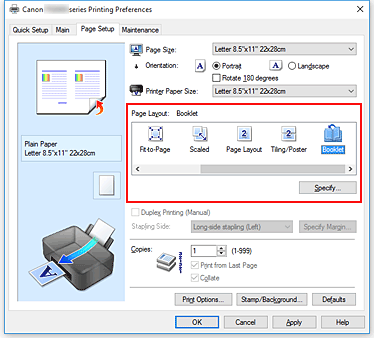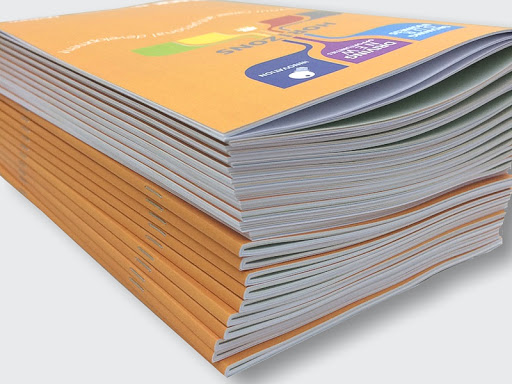Why Businesses in Miami Are Investing in Premium Booklet Printing
Why Businesses in Miami Are Investing in Premium Booklet Printing
Blog Article
The Essential Overview to Comprehending Booklet Printing Options and Techniques
The procedure of brochure printing includes multiple factors to consider that can considerably affect the end product. From picking the proper layout and dimension to understanding the subtleties of binding methods, each selection plays an important function. Additionally, elements such as paper stock and printing techniques additional affect the effectiveness of the booklet. As one navigates these options, it becomes vital to grasp just how they adjoin and what that indicates for the general outcome.
Comprehending Brochure Sizes and formats
When taking into consideration pamphlet printing, understanding the numerous styles and dimensions offered is vital for accomplishing the preferred presentation. Brochures can be generated in various layouts, consisting of saddle-stitched, spiral-bound, and perfect-bound, each offering distinct advantages. Common sizes range from typical letter (8.5 x 11 inches) to smaller alternatives like A5 (5.8 x 8.3 inches), enabling flexibility based on web content and target audience.Selecting the appropriate dimension can influence both the design and viewers interaction. Bigger sizes could fit visually driven web content, while smaller layouts may be extra portable and straightforward. Additionally, the variety of pages affects the selection of binding method, as thicker pamphlets might need tougher bindings. Inevitably, understanding these aspects enables a more tailored technique, making certain that the end product straightens with the desired message and visual, boosting the general efficiency of the communication.
Choosing the Right Paper Supply

Binding Approaches: Factors To Consider and alternatives
When it involves binding methods for booklets, a number of choices are offered, each with distinctive benefits. Saddle stitch binding provides a cost-effective option for thinner booklets, while perfect binding techniques offer an even more refined search for thicker publications. Wire-O binding stands out for its durability and ease of use, making it excellent for files that require versatility.
Saddle Stitch Binding
Saddle stitch binding offers a sensible and economical remedy for putting together booklets, making it a prominent choice among authors and organizations. This binding method involves folding sheets of paper in fifty percent and stapling them along the fold line, creating a neat and orderly look. Usually suitable for booklets with a reduced web page matter, saddle sewing is suitable for magazines, brochures, and educational products. The simpleness of this technique allows for fast manufacturing and is often preferred for short runs or promotional products. It is vital to note that saddle stitch binding might not be appropriate for thicker booklets, as the spine may not hold up under raised weight. Overall, it continues to be a trusted option for lots of printing projects.
Perfect Binding Methods
Perfect binding is a widely utilized method that offers a polished and specialist surface to booklets and magazines. This technique entails gluing the pages with each other at the spinal column utilizing a strong adhesive, enabling a tidy side and the capacity to hold a larger number of pages compared to saddle sewing. Perfect binding is especially suitable for thicker pamphlets, such as directories and yearly reports, where a sturdy, level spine is wanted. In addition, it uses the alternative for a printed cover that can be designed to boost visual appeal. Nevertheless, factors to consider such as web page count, paper weight, and the planned use the pamphlet should be considered, as they can influence toughness and total top quality.
Wire-O Binding Choices
Wire-O binding, recognized for its longevity and adaptability, supplies an outstanding option for brochures that call for very easy page transforming and an expert look. This binding method employs a series of metal loops that hold web pages safely, permitting them to exist flat when open. It is specifically ideal for guidebooks, magazines, and discussions as a result of its robust nature. Wire-O binding is readily available in various shades and sizes, fitting various page matters and densities. Additionally, it allows the incorporation of covers and tabs, enhancing the booklet's total aesthetic. Considerations for Wire-O binding include the selection of cord shade, the size of the loops, and the degree of personalization preferred, every one of which can profoundly influence the last item's look and capability.
Digital vs. Offset Printing: Which Is Best for You?
When choosing a printing approach for booklets, comprehending the differences in between digital and balance out printing is vital. Digital printing uses modern innovation to create high-quality prints swiftly and economically, making it perfect for short runs or jobs requiring fast turn-around times. It permits modification, supplying the ability to publish on-demand with minimal waste.In comparison, balance out printing is a conventional technique that masters creating huge amounts with regular quality. It involves transferring ink from a plate to a rubber covering, after that to the paper, which causes specific information and dynamic shades. Offset printing typically calls for longer configuration times and is more cost-efficient for larger volumes.Ultimately, the selection between electronic and offset printing depends on job demands, budget, and wanted quantity. For tiny, time-sensitive projects, digital could be the very best option, while offset may be better for bigger, top notch productions.

Creating Your Brochure: Tips and Ideal Practices
When developing a pamphlet, mindful interest to format, typeface option, and color use can greatly enhance its efficiency. A well-structured format guides the reader's eye, while suitable fonts assure readability and convey the preferred tone. Furthermore, reliable use color can evoke feelings and highlight essential info, making the total design much more impactful.
Picking the Right Layout
How can one efficiently pick the appropriate layout for a brochure? Initially, it is necessary to review the booklet's function and target market. A tidy, arranged layout improves readability and interaction. Utilizing a grid system can help in aligning components regularly, creating a professional appearance. Additionally, integrating visual hierarchy through varying sizes and positionings of images and text can guide the reader's eye and stress crucial information. It is likewise vital to leave enough white room, which avoids congestion and allows for much better focus. Evaluating different layouts with mock-ups can provide insight right into how the layout carries out in real-world circumstances, making sure that the final product satisfies both aesthetic and functional needs. Useful Choosing Appropriate Font Styles
A well-chosen font style can substantially improve the general design of a booklet, complementing the design and strengthening the material's message. The choice of typefaces should consider readability, especially for body message, as it assures the information is obtainable to all readers. Sans-serif fonts are often favored for digital formats, while serif fonts can lend a typical feel in published products. It's a good idea to her response limit font selections to 2 or 3 to keep visual comprehensibility. Additionally, typeface dimension plays a crucial duty; headings must be not frustrating yet distinctive, while body message should be comfortable for analysis. When choosing typefaces, placement with the booklet's theme and target market is important for efficient communication and visual appeal.
Efficient Use of Color
Color serves as a powerful device in pamphlet design, guiding and forming assumptions viewers emotions. It can evoke feelings of trust, calmness, or exhilaration, depending upon the colors picked. Designers ought to think about shade theory concepts, ensuring that the chosen combination lines up with the pamphlet's message and target audience. For example, utilizing warm shades like red and orange can develop seriousness, while cooler tones like green and blue foster tranquility.Additionally, contrast plays a vital role; complementary colors can improve readability and aesthetic charm. Consistency in color usage throughout web pages better enhances brand identity and cohesion. Inevitably, reliable color application not only records focus but likewise enhances the booklet's objective, making it a necessary facet of successful layout.
Completing Touches: Coatings and Special Effects
While numerous consider the material and design of a booklet one of the most crucial elements, the completing touches, such as coatings and unique impacts, play a vital duty in improving its overall allure. Coatings can provide security and durability, ensuring that the brochure holds up against wear and tear. Matte coatings supply an innovative, non-reflective surface, while glossy coatings can make shades show up more vibrant and captivating. Unique results, like embossing or foil stamping, include a tactile dimension that can create a memorable perception. These strategies can highlight certain areas, drawing focus to essential details or producing aesthetic passion. Additionally, UV coating can supply a high-shine surface that elevates the total look.Together, these completing touches not just boost the pamphlet's aesthetic yet also connect professionalism and interest to information, ultimately leaving a long lasting effect on the reader.
Expense Factors To Consider for Pamphlet Printing
Understanding the numerous cost factors to consider for pamphlet printing is important for companies and services intending to enhance their budget plans. Secret elements influencing expenses include the go to the website choice of paper, ink, and binding techniques. Greater high quality materials, such as superior paper or specialized inks, commonly boost the overall expense. Additionally, the size and page matter of the pamphlet play a significant function; larger pamphlets require even more sources and time to produce.Another crucial consideration is the printing method, whether digital or balanced out, as each has its own prices framework my blog and suitability for different amounts. Organizations ought to likewise factor in layout prices, which can vary based on complexity and using expert solutions. Eventually, delivery and handling fees can include in the total, specifically for large orders. By examining these elements, organizations can make informed decisions that straighten with their economic capabilities while accomplishing the preferred high quality in their printed materials.
Regularly Asked Inquiries
What Are the Ecological Effects of Pamphlet Printing?
The environmental influences of brochure printing consist of logging from paper manufacturing, carbon emissions from transport, and waste generation from discarded materials - Booklet Printing. Sustainable techniques, such as utilizing recycled paper and eco-friendly inks, can alleviate these effects
Exactly How Can I Make Certain Shade Precision in My Booklet?
To assure color precision in a brochure, one should use calibrated screens, employ expert shade profiles, conduct test prints, and pick high-grade printing solutions that offer shade matching and proofing alternatives for best results.
What Is the Typical Turn-around Time for Booklet Printing?
The common turnaround time for pamphlet printing varies depending upon the intricacy and quantity - Booklet Printing. Typically, it ranges from a few days to 2 weeks, affected by elements such as printing approaches and finishing needs
Exist Minimum Order Quantities for Booklet Printing?

Can I Publish Booklets in Numerous Languages?
Publishing brochures in multiple languages is possible. Lots of printing services supply options for multilingual or multilingual designs, permitting for reliable interaction. Careful preparation assurances that create aspects fit different languages without jeopardizing readability or visual appeals. Additionally, variables such as paper stock and printing methods more influence the effectiveness of the pamphlet. When considering pamphlet printing, recognizing the various layouts and sizes available is essential for achieving the desired presentation. When choosing a printing method for booklets, understanding the differences in between electronic and balance out printing is necessary. In addition, the size and page count of the pamphlet play a significant function; larger brochures call for more sources and time to produce.Another important consideration is the printing strategy, whether digital or balanced out, as each has its own prices structure and suitability for various amounts. The environmental effects of brochure printing include logging from paper production, carbon discharges from transport, and waste generation from thrown out products.
Report this page